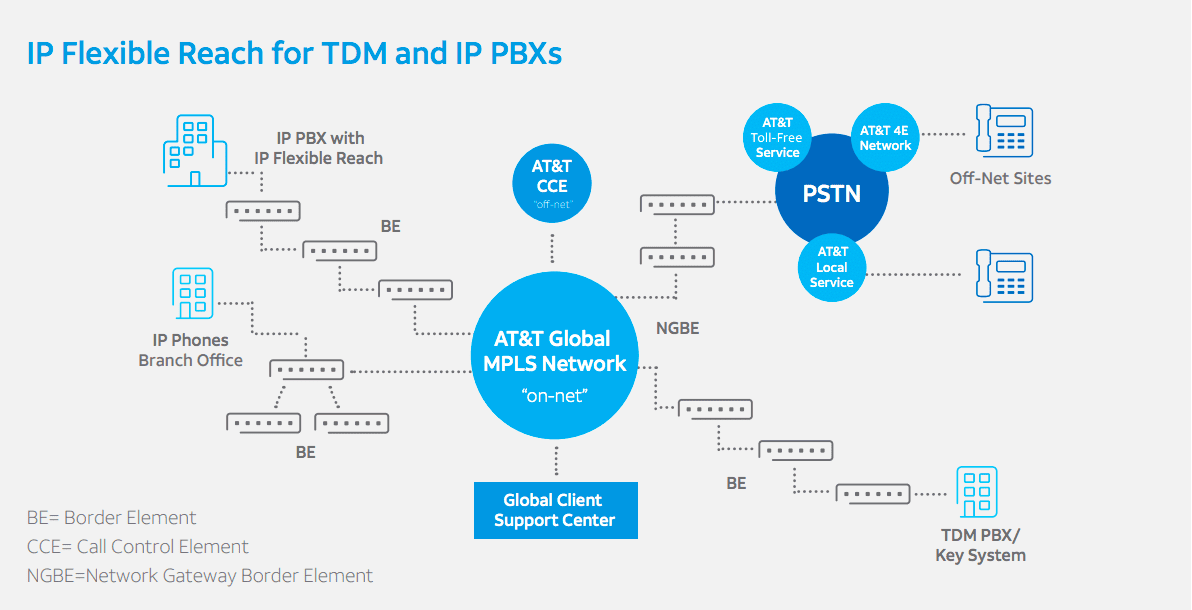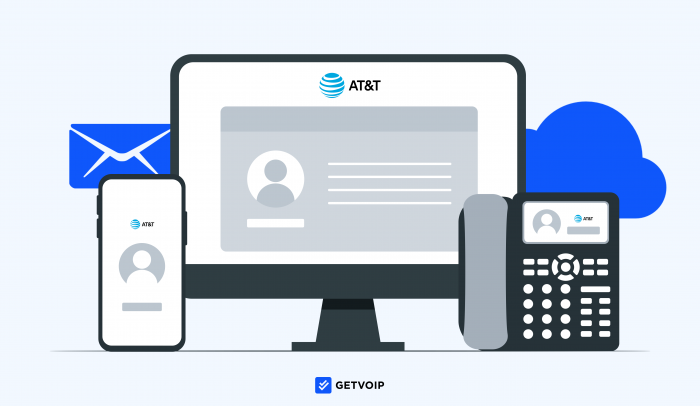Session Initiation Protocol (SIP) trunking helps businesses expand their phone systems to make calls over the Internet. Several VoIP service providers offer SIP trunking solutions that enable your IP PBX or SIP Server with cloud-based phone service, for calling over the web or PSTN.
AT&T IP Flexible Reach, the provider’s SIP trunking and business VoIP service, offers VoIP and PSTN calling around the globe, using your on-premise IP PBX system. This article will outline AT&T IP Flexible Reach in detail, covering the product’s features, benefits, and pricing.
What is AT&T IP Flexible Reach?
AT&T IP Flexible Reach is AT&T’s SIP trunking service that provides business clients with inbound, outbound, long-distance, and international calling over VoIP and PSTN. The service prioritizes voice calling but also allows businesses to transmit data for applications using chat, file transfers, and web conferencing. The telephony system includes standard calling features like voicemail, remote call forwarding, caller ID, and a web portal for account management.
Companies can purchase as many SIP trunking lines as they want from AT&T, provisioning these lines for users and offices based anywhere. The SIP trunking service utilizes your on-premise telephony system and SIP network element, such as a session border controller (SBC) or IP PBX, routing your call data through AT&T’s VoIP and PSTN networks.
How Does AT&T Flexible Reach Work?
As a SIP trunking solution, AT&T IP Flexible Reach utilizes your on-premise telephony system to provide AT&T-based phone service over the Internet or PSTN. Choose how many concurrent phone lines or “trunks” your business will need, pay a monthly subscription, and your users can begin making calls to anywhere in the world.
Before signing up with AT&T Flexible Reach, your company must have a SIP network element–such as an IP PBX, SIP server, or session border controller. Any locations that want to use Flexible Reach must have this hardware or software component. Further, the service requires that you use AT&T Dedicated Internet (ADI) for web connectivity.
Once you sign up, users connected to your local network and SIP system can make calls from VoIP phones, using the trunking lines you’ve purchased. When users are on a call, the local network converts the audio into data packets, transmitting them to AT&T’s VoIP data centers. From here, AT&T sends the voice data packets to their destination via the Internet or traditional public-switched telephone network (PSTN).
AT&T SIP Trunking Pricing and Plans
AT&T IP Flexible Reach offers three business plans: Plan A, B, and C. Pricing varies by location, so you must provide your business address before receiving a custom quote. For our location in Queens, New York, IP Flexible Reach would cost about $17 monthly per trunking line–without ADI.
IP Flexible Reach requires AT&T Dedicated Internet (ADI), a fiber-optic service with fast speeds up to 10 Gbps. If you don’t already have ADI, you’ll have to purchase it alongside Flexible Reach–which significantly adds to the price. For both services, our cost in New York was around $86 total per line. Depending on your location, expect to pay anywhere from $75 to $90 per month for ADI and IP Flexible Reach. While expensive, ADI is very fast, which substantially improves VoIP call quality.
AT&T IP Flexible Reach offers three calling plans, each with its own pricing structure. Each plan includes unlimited on-net (VoIP to VoIP) calling.
Calling Plan A: Unlimited On-Net Calling
The cheapest Flexible Reach plan, Plan A grants unlimited on-net calling to other VoIP numbers. This is useful for fostering communications between your company’s sites, or for corresponding with any other businesses that use VoIP. Off-net calls that use the PSTN will incur a higher per-minute rate, regardless of whether they’re local or long-distance.
While the exact subscription varies by location, this plan offers the cheapest starting cost for AT&T Flexible Reach.
Calling Plan B: Local and Long Distance
Calling Plan B offers the same features as A, plus unlimited inbound and outbound local calling using the PSTN. While this plan is more expensive than B, it enables you to call any domestic number using landline or VoIP. Long-distance calls incur a metered, per-minute charge. This plan works well for businesses that call a wide variety of numbers across the US.
Calling Plan C: Local and Long Distance
Plan C includes all the features and unlimited calling options from A and B, plus a bundle of 300 monthly long-distance off-net minutes per concurrent call line. With a slightly higher subscription cost than Plan B, Plan A makes a good option for teams that often dial long-distance destinations.
Benefits of AT&T IP Flexible Reach

Compared to a landline or an alternative SIP trunking provider, here are the benefits of using AT&T Flexible Reach:
- AT&T technical support
- Optimizes IP network capacity
- Using current hardware
- Quality of Service (QoS)
- Scalable communication channels
AT&T Technical Support
Managing a business phone system requires a lot of hands-on technical expertise, but with AT&T IP Flexible Reach, your business will have access to the AT&T technical team. They coordinate and provide onsite installation, which includes installing routers and connecting POTS lines so that AT&T has remote access to the system.
Optimized IP Network Capacity
A business phone system uses a lot of information to handle everyday calls, so you must have voice integrations and data integrations. This AT&T SIP trunking system combines data from your IP address and holds it in a space that is managed easily.
Using Current Hardware
When a business invests in new phone lines, purchasing new hardware to get the system up and running is often required. With AT&T IP Flexible reach, there is no need for this purchase because most businesses using their existing IP or TDM PBX lines. Reducing equipment reduces the startup costs for a company.
Quality of Service (QoS)
Call quality is essential for business communication, and AT&T prioritizes QoS in their VoIP phone systems. Public internet and networks often have lag or latency that reduces the quality of the call. To eliminate this and maintain QoS, AT&T utilizes its MPLS network.
Scalable Communications Channels
The AT&T IP Flexible Reach System allows you to instantly increase or decrease the number of concurrent calls your phone system supports, making scaling much easier.
This makes AT&T SIP trunking much more cost-efficient than a landline’s primary rate interface (PRI) method, which provides high call quality and some data transmission but is limited to 23 communication channels per upgrade. With PRI, whether you want one or 24 extra lines added, you must purchase one batch of 23 lines for your office. In our guide comparing SIP vs PRI, we dive into the details of what to expect.
AT&T SIP Trunking Standout Features
AT&T IP Flexible Reach offers the following features as part of its SIP trunking service.
- Flexible calling plans
- Web-based portal
- Virtual phone numbers
Flexible Calling Plans
AT&T IP Flexible Reach offers several calling options, enabling businesses to choose the most cost-effective structure. Each plan includes unlimited VoIP-to-VoIP calling, with value options for frequent local or long-distance calling.
Web-based Portal for Detailed Reporting
This AT&T business phone system has a web-based portal that businesses use to get information about the calls such as performance reporting, maintenance reports, and other actionable call center analytics.
Virtual Phone Numbers
Virtual phone numbers let businesses choose phone numbers from area codecs across the country, providing more freedom than landline numbers restricted to your office’s street address.
With AT&T Flexible Reach, you can purchase virtual telephone numbers anywhere around the country within AT&T’s VoIP network. Assign these numbers to users anywhere in the world, establishing a local presence in new areas or unifying offices that are based far apart. With the web-based portal, administrators can purchase and assign AT&T phone numbers in minutes.
How Do AT&T SIP Trunking Plans Compare?
To give you an idea of how AT&T IP Flexible Reach stacks up against competitors, we’ve compared it to some of today’s top SIP trunking solutions.
Twilio
Twilio SIP trunking has been very successful - they are trusted by more than 50,000 businesses worldwide. Twilio offers elastic SIP trunking, with the option for per-minute pricing or a monthly subscription for a fixed number of trunks. Twilio was rewarded top marks in customer satisfaction by Eastern Management Group for SIP trunking.
Like AT&T, Twilio has a highly secure and stable network backbone. On their VoIP services platform, you can analyze call data via their insights and find out if you’re losing packets during inbound and outbound dialing. Unlike AT&T, Twilio doesn’t have a voice calls-first CoS feature, so there is the potential for reduced call quality with heavier network congestion.
Unitel
Unitel has pay-as-you-go plans for the SIP trunking solution and volume-based plans that provide a flat rate for committed use. Like AT&T, its pricing is quote-based and varies by your business location. For toll-free calls, their rates start at $0.0180 per minute for origination. For local phone numbers, plan to spend $0.0045 per minute for outbound calls and about $0.0069 per minute for inbound.
Unitel prides itself on having carrier-grade pricing that is straightforward. Users won’t have to worry about “reasonable use policies,” which limit calling capacity on unlimited plans. Compared to Unitel, AT&T makes it easier to create branch office extensions by sharing trunks across multiple locations.
Comcast
Similarly to AT&T SIP trunking, Comcast’s SIP trunks provide virtual direct inward dial (DID) numbers for your employees so that they are reachable by customers on dedicated lines. For this service, you’ll also need to be on Comcast’s network. Comcast also has a cloud-based PBX solution called Comcast Business VoiceEdge for those without existing PBX hardware.
The bandwidth on their SIP trunks isn’t fiber optic, so you’re limited to 100 Mbps speeds. This is significantly slower than AT&T’s 10 Gbps bandwidth. AT&T IP Flexible Reach has a few features that Comcast doesn’t offer, like anonymous call rejection, which automatically refuses calls that don’t provide information on the caller ID. Another feature that’s present on AT&T is “call forwarding – always”, which automatically redirects calls from one line to another.
AT&T SIP Trunking Opens Up Opportunities
AT&T SIP trunking via its IP Flexible Reach solution is for businesses that are looking to shed public switched telephone network (PSTN) or primary rate interface (PRI) setups. This kind of upgrade adds scalability and consistency to business communications. This isn’t to say that there aren’t drawbacks to the service. Some distinct weaknesses include:
- You’ll be locked into the ADI network, which is costly
- There’s no clear rate since everything is based on location
- Businesses are limited to 300 long-distance minutes per line with Calling Plan C
Still, this is a plan that can prove useful for organizations with multiple offices that may have preexisting TDM, IP, or hosted PBX setups since trunks can be shared across multiple locations. Want to learn more about your options? Check out our interactive tables for enterprise VoIP solutions.



